They’ve outgrown another set of outfits, gone up a few diaper sizes and need bigger shoes – but have you checked they still fit into their car seat safely?
When to switch to a toddler seat
At around 12 months, you should start thinking about moving your baby from the rear-facing car seat they had at birth to a toddler seat. Before you do, check to see if your child’s head is level with the top of their seat and definitely make the switch if their head is more than two fingers above the highest point of the seat shell. Also make sure your baby can sit up unaided as toddler seats are generally more upright.
Toddler seats
These can be used from approximately six months up to around four years depending on the height and weight of your child and most have built-in internal harnesses to secure your little one. It’s recommended to keep your child in a rear-facing seat until they are at least 15 months old for extra protection whilst their necks strengthen. Many toddler seats can be used both rear and front facing and are adjustable so they can grow with your child. Again, once your toddler’s head reaches the top of the seat, you might have to think about changing seats.
High-back booster seats
These are generally used from around four years, are lighter in weight and use the car’s seat belt to hold the child in place. On some models the back can detach so the seat can be used more comfortably for older children until they are ten and can travel using just an adult seatbelt.
Height or weight
Children all grow at different rates and it can be hard to give a specific age or weight as to when you should change seats. This is why the most recent legislation in Europe uses a child’s height to work out the right fit and to tell you when it’s time to move up a car seat size. The new European standard for child car seats is known as i-Size and will be clearly labeled with the specific height the seat is suitable for. Although these regulations are not part of Saudi law, they are a useful standard to follow. For more information see the United Nations regulations.
https://www.unece.org/fileadmin/DAM/trans/publications/WP29/CHILD_RESTRAINT_SYSTEMS_brochure.pdf
Coat
It’s not a good idea to let your child wear a thick coat when strapped into a car seat. The added bulk means that you’ll have to loosen the harness to make it fit and if there was a crash, your child could be propelled forward. On chilly days it’s much better to tuck a blanket over your little one to keep them warm.
Fit it right
Car seats can be secured to your vehicle in two ways. If your seat has ISOFIX fixtures, these slot into your car’s ISOFIX anchorage points in the back seat. So before buying a seat with these fittings, check with your car’s manufacturer to make sure it will fit your specific car model. The other way you can attach a seat is by using the car’s seat belt. If you’re in any doubt, get in touch with your car manufacturer or check their website to ensure you’re fitting it correctly as it can be dangerous to travel if the seat isn’t secure.
Shop The Range of Car Seats



